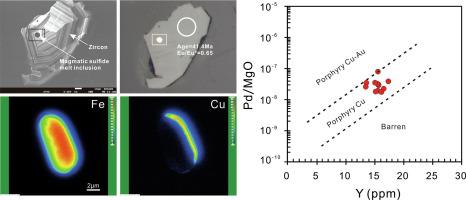当前位置:
X-MOL 学术
›
Ore Geol. Rev.
›
论文详情
Our official English website, www.x-mol.net, welcomes your
feedback! (Note: you will need to create a separate account there.)
The role of early sulfide saturation in the formation of the Yulong porphyry Cu-Mo deposit: Evidence from mineralogy of sulfide melt inclusions and platinum-group element geochemistry
Ore Geology Reviews ( IF 3.2 ) Pub Date : 2020-09-01 , DOI: 10.1016/j.oregeorev.2020.103644 Ming-Liang Huang , Jian-Feng Gao , Xian-Wu Bi , Lei-Luo Xu , Jing-Jing Zhu , Da-Peng Wang
Ore Geology Reviews ( IF 3.2 ) Pub Date : 2020-09-01 , DOI: 10.1016/j.oregeorev.2020.103644 Ming-Liang Huang , Jian-Feng Gao , Xian-Wu Bi , Lei-Luo Xu , Jing-Jing Zhu , Da-Peng Wang

|
Abstract Sulfide melt inclusions enclosed in silicate minerals have been observed in many oxidized Cu-bearing porphyries. The origin of such sulfide melt inclusions could bear critical information of metal enrichment or depletion during magma evolution of porphyry systems. The giant Yulong porphyry Cu-Mo deposit in eastern Tibetan Plateau consists of a series of felsic intrusions, among which the mineralized Yulong intrusion emplaced at a late stage of the magmatic activity. This study reports detailed texture and composition of sulfide melt inclusions from barren and mineralized intrusions, as well as platinum-group elements of these intrusions, to evaluate potential role of early sulfide saturation in the porphyry mineralization system. These sulfide melt inclusions, occurring as globules or droplets, are preserved in zircon, amphibole and quartz grains. Most of them are composed of a major phase of pyrrhotite and minor pyrite, chalcopyrite and pentlandite. Smooth boundaries between these phases suggest the origin of fractionation from sulfide melt upon cooling. Small amounts of Cu and Ni are heterogeneously distributed in the pyrrhotite. The sulfide melt inclusions could be observed in both the pre- and syn-mineralization intrusions at Yulong, indicating that sulfide saturation had commonly occurred during magma evolution. Magnetite mineral inclusions could be observed in zircon and amphibole grains as well. The mineral assemblage of magnetite + pyrrhotite + pyrite of the mineral inclusions constrains the Yulong magmatic system to redox conditions near the magnetite-pyrite/pyrrhotite buffer and above the fayalite/ magnetite-quartz buffer (FMQ). High Eu/Eu* values (0.56–0.78) of the hosting zircons and high calculated ΔNNO values (>0.5) of the hosting amphibole indicate highly oxidized nature of the parental magma. Both pre- and syn-mineralization intrusions have low PGE contents (Pt = 0.04 to 0.17 ppb, Pd = 0.19–0.60 ppb) with compositions plotting in the Au-poor porphyry Cu fields in discriminating diagrams. Early sulfide saturation may have been reached and small amounts of sulfides have been segregated from magma. Most PGEs and Au but little Cu have been removed from the evolved magma because the partition coefficient of Cu between sulfide and silicate melt is about two orders of magnitude lower than PGE or Au. As a consequence, the evolved magma would have high Cu but very low PGE and Au, resulting in the Au-poor porphyry Cu mineralization at Yulong.
中文翻译:

早期硫化物饱和在玉龙斑岩铜钼矿床形成中的作用:来自硫化物熔体包裹体矿物学和铂族元素地球化学的证据
摘要 在许多氧化铜斑岩中都观察到了包裹在硅酸盐矿物中的硫化物熔体包裹体。这种硫化物熔体包裹体的来源可能包含斑岩系统岩浆演化过程中金属富集或消耗的关键信息。青藏高原东部巨大的玉龙斑岩铜钼矿床由一系列长英质侵入体组成,其中矿化的玉龙侵入体位于岩浆活动晚期。本研究报告了来自贫瘠和矿化侵入体的硫化物熔体包裹体的详细结构和组成,以及这些侵入体的铂族元素,以评估早期硫化物饱和在斑岩矿化系统中的潜在作用。这些硫化物熔体包裹体以球状或液滴形式存在,保存在锆石中,闪石和石英颗粒。它们中的大多数由磁黄铁矿和次要黄铁矿、黄铜矿和镍黄铁矿的主相组成。这些相之间的平滑边界表明硫化物熔体在冷却时分馏的起源。少量的 Cu 和 Ni 不均匀地分布在磁黄铁矿中。玉龙矿化前和同矿化侵入体均可见硫化物熔体包裹体,表明在岩浆演化过程中普遍发生硫化物饱和。在锆石和角闪石颗粒中也可以观察到磁铁矿矿物包裹体。矿物包裹体的磁铁矿+磁黄铁矿+黄铁矿的矿物组合将玉龙岩浆系统限制在磁铁矿-黄铁矿/磁黄铁矿缓冲液附近和铁橄榄石/磁铁矿-石英缓冲液(FMQ)上方的氧化还原条件。高 Eu/Eu* 值 (0. 56–0.78) 的寄主锆石和寄主角闪石的高计算 ΔNNO 值 (>0.5) 表明母岩浆的高度氧化性质。预矿化侵入体和同矿化侵入体都具有低 PGE 含量(Pt = 0.04 至 0.17 ppb,Pd = 0.19-0.60 ppb),其成分在鉴别图中绘制在贫金斑岩铜场中。早期的硫化物可能已经达到饱和,少量的硫化物已经从岩浆中分离出来。大多数 PGEs 和 Au 但很少的 Cu 已经从演化的岩浆中去除,因为 Cu 在硫化物和硅酸盐熔体之间的分配系数比 PGE 或 Au 低大约两个数量级。因此,演化出的岩浆中铜含量较高,但铂族元素和金含量非常低,导致玉龙出现贫金的斑岩铜矿化。78) 的寄主锆石和高计算的 ΔNNO 值 (>0.5) 寄主角闪石表明母岩浆的高度氧化性质。预矿化侵入体和同矿化侵入体都具有低 PGE 含量(Pt = 0.04 至 0.17 ppb,Pd = 0.19-0.60 ppb),其成分在鉴别图中绘制在贫金斑岩铜场中。早期的硫化物可能已经达到饱和,少量的硫化物已经从岩浆中分离出来。大多数 PGEs 和 Au 但很少的 Cu 已经从演化的岩浆中去除,因为 Cu 在硫化物和硅酸盐熔体之间的分配系数比 PGE 或 Au 低大约两个数量级。因此,演化出的岩浆中铜含量较高,但铂族元素和金含量非常低,导致玉龙出现贫金的斑岩铜矿化。78) 的寄主锆石和高计算的 ΔNNO 值 (>0.5) 寄主角闪石表明母岩浆的高度氧化性质。预矿化侵入体和同矿化侵入体都具有低 PGE 含量(Pt = 0.04 至 0.17 ppb,Pd = 0.19-0.60 ppb),其成分在鉴别图中绘制在贫金斑岩铜场中。早期的硫化物可能已经达到饱和,少量的硫化物已经从岩浆中分离出来。大多数 PGEs 和 Au 但很少的 Cu 已经从演化的岩浆中去除,因为 Cu 在硫化物和硅酸盐熔体之间的分配系数比 PGE 或 Au 低大约两个数量级。因此,演化出的岩浆中铜含量较高,但铂族元素和金含量非常低,导致玉龙出现贫金的斑岩铜矿化。5) 承载角闪石表明母岩浆的高度氧化性质。预矿化侵入体和同矿化侵入体都具有低 PGE 含量(Pt = 0.04 至 0.17 ppb,Pd = 0.19-0.60 ppb),其成分在鉴别图中绘制在贫金斑岩铜场中。早期的硫化物可能已经达到饱和,少量的硫化物已经从岩浆中分离出来。大多数 PGEs 和 Au 但很少的 Cu 已经从演化的岩浆中去除,因为 Cu 在硫化物和硅酸盐熔体之间的分配系数比 PGE 或 Au 低大约两个数量级。因此,演化出的岩浆中铜含量较高,但铂族元素和金含量非常低,导致玉龙出现贫金的斑岩铜矿化。5) 承载角闪石表明母岩浆的高度氧化性质。预矿化侵入体和同矿化侵入体都具有低 PGE 含量(Pt = 0.04 至 0.17 ppb,Pd = 0.19-0.60 ppb),其成分在鉴别图中绘制在贫金斑岩铜场中。早期的硫化物可能已经达到饱和,少量的硫化物已经从岩浆中分离出来。大多数 PGEs 和 Au 但很少的 Cu 已经从演化的岩浆中去除,因为 Cu 在硫化物和硅酸盐熔体之间的分配系数比 PGE 或 Au 低大约两个数量级。因此,演化出的岩浆中铜含量较高,但铂族元素和金含量非常低,导致玉龙出现贫金的斑岩铜矿化。17 ppb,Pd = 0.19–0.60 ppb),在鉴别图中绘制贫金斑岩铜场中的成分。早期的硫化物可能已经达到饱和,少量的硫化物已经从岩浆中分离出来。大多数 PGEs 和 Au 但很少的 Cu 已经从演化的岩浆中去除,因为 Cu 在硫化物和硅酸盐熔体之间的分配系数比 PGE 或 Au 低大约两个数量级。因此,演化出的岩浆中铜含量较高,但铂族元素和金含量非常低,导致玉龙出现贫金的斑岩铜矿化。17 ppb,Pd = 0.19–0.60 ppb),在鉴别图中绘制贫金斑岩铜场中的成分。早期的硫化物可能已经达到饱和,少量的硫化物已经从岩浆中分离出来。大多数 PGEs 和 Au 但很少的 Cu 已经从演化的岩浆中去除,因为 Cu 在硫化物和硅酸盐熔体之间的分配系数比 PGE 或 Au 低大约两个数量级。因此,演化出的岩浆中铜含量较高,但铂族元素和金含量非常低,导致玉龙出现贫金的斑岩铜矿化。大多数 PGEs 和 Au 但很少的 Cu 已经从演化的岩浆中去除,因为 Cu 在硫化物和硅酸盐熔体之间的分配系数比 PGE 或 Au 低大约两个数量级。因此,演化出的岩浆中铜含量较高,但铂族元素和金含量非常低,导致玉龙出现贫金的斑岩铜矿化。大多数 PGEs 和 Au 但很少的 Cu 已经从演化的岩浆中去除,因为 Cu 在硫化物和硅酸盐熔体之间的分配系数比 PGE 或 Au 低大约两个数量级。因此,演化出的岩浆中铜含量较高,但铂族元素和金含量非常低,导致玉龙出现贫金的斑岩铜矿化。
更新日期:2020-09-01
中文翻译:

早期硫化物饱和在玉龙斑岩铜钼矿床形成中的作用:来自硫化物熔体包裹体矿物学和铂族元素地球化学的证据
摘要 在许多氧化铜斑岩中都观察到了包裹在硅酸盐矿物中的硫化物熔体包裹体。这种硫化物熔体包裹体的来源可能包含斑岩系统岩浆演化过程中金属富集或消耗的关键信息。青藏高原东部巨大的玉龙斑岩铜钼矿床由一系列长英质侵入体组成,其中矿化的玉龙侵入体位于岩浆活动晚期。本研究报告了来自贫瘠和矿化侵入体的硫化物熔体包裹体的详细结构和组成,以及这些侵入体的铂族元素,以评估早期硫化物饱和在斑岩矿化系统中的潜在作用。这些硫化物熔体包裹体以球状或液滴形式存在,保存在锆石中,闪石和石英颗粒。它们中的大多数由磁黄铁矿和次要黄铁矿、黄铜矿和镍黄铁矿的主相组成。这些相之间的平滑边界表明硫化物熔体在冷却时分馏的起源。少量的 Cu 和 Ni 不均匀地分布在磁黄铁矿中。玉龙矿化前和同矿化侵入体均可见硫化物熔体包裹体,表明在岩浆演化过程中普遍发生硫化物饱和。在锆石和角闪石颗粒中也可以观察到磁铁矿矿物包裹体。矿物包裹体的磁铁矿+磁黄铁矿+黄铁矿的矿物组合将玉龙岩浆系统限制在磁铁矿-黄铁矿/磁黄铁矿缓冲液附近和铁橄榄石/磁铁矿-石英缓冲液(FMQ)上方的氧化还原条件。高 Eu/Eu* 值 (0. 56–0.78) 的寄主锆石和寄主角闪石的高计算 ΔNNO 值 (>0.5) 表明母岩浆的高度氧化性质。预矿化侵入体和同矿化侵入体都具有低 PGE 含量(Pt = 0.04 至 0.17 ppb,Pd = 0.19-0.60 ppb),其成分在鉴别图中绘制在贫金斑岩铜场中。早期的硫化物可能已经达到饱和,少量的硫化物已经从岩浆中分离出来。大多数 PGEs 和 Au 但很少的 Cu 已经从演化的岩浆中去除,因为 Cu 在硫化物和硅酸盐熔体之间的分配系数比 PGE 或 Au 低大约两个数量级。因此,演化出的岩浆中铜含量较高,但铂族元素和金含量非常低,导致玉龙出现贫金的斑岩铜矿化。78) 的寄主锆石和高计算的 ΔNNO 值 (>0.5) 寄主角闪石表明母岩浆的高度氧化性质。预矿化侵入体和同矿化侵入体都具有低 PGE 含量(Pt = 0.04 至 0.17 ppb,Pd = 0.19-0.60 ppb),其成分在鉴别图中绘制在贫金斑岩铜场中。早期的硫化物可能已经达到饱和,少量的硫化物已经从岩浆中分离出来。大多数 PGEs 和 Au 但很少的 Cu 已经从演化的岩浆中去除,因为 Cu 在硫化物和硅酸盐熔体之间的分配系数比 PGE 或 Au 低大约两个数量级。因此,演化出的岩浆中铜含量较高,但铂族元素和金含量非常低,导致玉龙出现贫金的斑岩铜矿化。78) 的寄主锆石和高计算的 ΔNNO 值 (>0.5) 寄主角闪石表明母岩浆的高度氧化性质。预矿化侵入体和同矿化侵入体都具有低 PGE 含量(Pt = 0.04 至 0.17 ppb,Pd = 0.19-0.60 ppb),其成分在鉴别图中绘制在贫金斑岩铜场中。早期的硫化物可能已经达到饱和,少量的硫化物已经从岩浆中分离出来。大多数 PGEs 和 Au 但很少的 Cu 已经从演化的岩浆中去除,因为 Cu 在硫化物和硅酸盐熔体之间的分配系数比 PGE 或 Au 低大约两个数量级。因此,演化出的岩浆中铜含量较高,但铂族元素和金含量非常低,导致玉龙出现贫金的斑岩铜矿化。5) 承载角闪石表明母岩浆的高度氧化性质。预矿化侵入体和同矿化侵入体都具有低 PGE 含量(Pt = 0.04 至 0.17 ppb,Pd = 0.19-0.60 ppb),其成分在鉴别图中绘制在贫金斑岩铜场中。早期的硫化物可能已经达到饱和,少量的硫化物已经从岩浆中分离出来。大多数 PGEs 和 Au 但很少的 Cu 已经从演化的岩浆中去除,因为 Cu 在硫化物和硅酸盐熔体之间的分配系数比 PGE 或 Au 低大约两个数量级。因此,演化出的岩浆中铜含量较高,但铂族元素和金含量非常低,导致玉龙出现贫金的斑岩铜矿化。5) 承载角闪石表明母岩浆的高度氧化性质。预矿化侵入体和同矿化侵入体都具有低 PGE 含量(Pt = 0.04 至 0.17 ppb,Pd = 0.19-0.60 ppb),其成分在鉴别图中绘制在贫金斑岩铜场中。早期的硫化物可能已经达到饱和,少量的硫化物已经从岩浆中分离出来。大多数 PGEs 和 Au 但很少的 Cu 已经从演化的岩浆中去除,因为 Cu 在硫化物和硅酸盐熔体之间的分配系数比 PGE 或 Au 低大约两个数量级。因此,演化出的岩浆中铜含量较高,但铂族元素和金含量非常低,导致玉龙出现贫金的斑岩铜矿化。17 ppb,Pd = 0.19–0.60 ppb),在鉴别图中绘制贫金斑岩铜场中的成分。早期的硫化物可能已经达到饱和,少量的硫化物已经从岩浆中分离出来。大多数 PGEs 和 Au 但很少的 Cu 已经从演化的岩浆中去除,因为 Cu 在硫化物和硅酸盐熔体之间的分配系数比 PGE 或 Au 低大约两个数量级。因此,演化出的岩浆中铜含量较高,但铂族元素和金含量非常低,导致玉龙出现贫金的斑岩铜矿化。17 ppb,Pd = 0.19–0.60 ppb),在鉴别图中绘制贫金斑岩铜场中的成分。早期的硫化物可能已经达到饱和,少量的硫化物已经从岩浆中分离出来。大多数 PGEs 和 Au 但很少的 Cu 已经从演化的岩浆中去除,因为 Cu 在硫化物和硅酸盐熔体之间的分配系数比 PGE 或 Au 低大约两个数量级。因此,演化出的岩浆中铜含量较高,但铂族元素和金含量非常低,导致玉龙出现贫金的斑岩铜矿化。大多数 PGEs 和 Au 但很少的 Cu 已经从演化的岩浆中去除,因为 Cu 在硫化物和硅酸盐熔体之间的分配系数比 PGE 或 Au 低大约两个数量级。因此,演化出的岩浆中铜含量较高,但铂族元素和金含量非常低,导致玉龙出现贫金的斑岩铜矿化。大多数 PGEs 和 Au 但很少的 Cu 已经从演化的岩浆中去除,因为 Cu 在硫化物和硅酸盐熔体之间的分配系数比 PGE 或 Au 低大约两个数量级。因此,演化出的岩浆中铜含量较高,但铂族元素和金含量非常低,导致玉龙出现贫金的斑岩铜矿化。











































 京公网安备 11010802027423号
京公网安备 11010802027423号